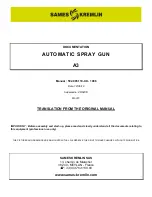
Operation
10
3A1190H
Adjusting the Pressure
When adjusting the pressure, turn the Pressure Control
Knob clockwise to increase pressure and counterclock
wise to decrease pressure. Always use the lowest pres
sure necessary to completely atomize the material. If
more coverage is needed, use a larger tip rather than
increasing the pressure.
Operating the sprayer at higher pressure than needed
wastes material, causes early tip wear, and shortens
sprayer life.
Check the spray pattern. The tip size and angle deter
mines the pattern width and flow rate.
Shutdown
1.
Relieve Pressure
, page 7.
2. Clean the tip and gun as recommended in the sepa
rate Gun Manual supplied with the gun.
3. If spraying water-based material or a material that
could harden in the sprayer overnight, flush the
sprayer after use. See
Flushing
, page 8.
Storage
Short Term
1. Flush sprayer with compatible solvent before stor
ing, then fill the pump and hoses with an oil based
solvent such as mineral spirits or Airlessco Pump
Conditioner.
•
For oil base paint: flush with mineral spirits
•
For water-base paint: flush with water, then min
eral spirits and leave the pump, hose and gun
filled with mineral spirits.
Long Term
For longer storage, use Airlessco Pump Conditioner.
Shut off sprayer,
Relieve Pressure
, page 7, and make
sure prime/pressure relief valve is left open.
Start Up After Storage
Before using water-base paint, flush sprayer with soapy
water and then a clean water flush. When using oil-base
paint, flush out the mineral spirits with the material to be
sprayed.
Always store unit indoors.
•
To reduce the risk of injection, never hold your
hand, body, fingers or hand in a rag in front of the
spray tip when cleaning or checking for a cleared
tip. Always point the gun toward the ground or into
a waste container when checking to see if the tip is
cleared or when using a self cleaning tip.
•
When you spray into the paint bucket, always use
the lowest spray pressure and maintain firm metal
to metal contact between the gun and container.
•
To stop the unit in an emergency, turn the engine
off. Then relieve the fluid pressure in the pump
and hose. See
Pressure Relief Procedure
, page











































